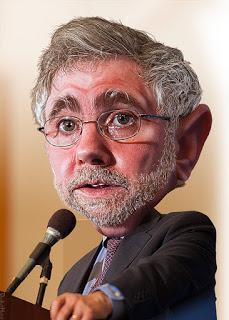 If you just listened to the cable news networks, you might think the campaign of Hillary Clinton is in trouble. That is just not true. Those networks want you to think that, because a close election gets them many more viewers (and they make more money with more viewers). The truth is that Clinton is already assured of the Democratic nomination, and is leading Donald Trump in both the national polls and the electoral college projections.
If you just listened to the cable news networks, you might think the campaign of Hillary Clinton is in trouble. That is just not true. Those networks want you to think that, because a close election gets them many more viewers (and they make more money with more viewers). The truth is that Clinton is already assured of the Democratic nomination, and is leading Donald Trump in both the national polls and the electoral college projections.Here is how Paul Krugman describes it is his New York Times column:
This is my fifth presidential campaign as a New York Times columnist, so I’ve watched a lot of election coverage, and I came into this cycle prepared for the worst. Or so I thought. But I was wrong. So far, election commentary has been even worse than I imagined it would be. It’s not just the focus on the horse race at the expense of substance; much of the horse-race coverage has been bang-your-head-on-the-desk awful, too. I know this isn’t scientific, but based on conversations I’ve had recently, many people — smart people, who read newspapers and try to keep track of events — have been given a fundamentally wrong impression of the current state of play. And when I say a “wrong impression,” I don’t mean that I disagree with other people’s takes. I mean that people aren’t being properly informed about the basic arithmetic of the situation. Now, I’m not a political scientist or polling expert, nor do I even try to play one on TV. But I am fairly numerate, and I assiduously follow real experts like The Times’s Nate Cohn. And they’ve taught me some basic rules that I keep seeing violated. First, at a certain point you have to stop reporting about the race for a party’s nomination as if it’s mainly about narrative and “momentum.” That may be true at an early stage, when candidates are competing for credibility and dollars. Eventually, however, it all becomes a simple, concrete matter of delegate counts. That’s why Hillary Clinton will be the Democratic nominee; she locked it up over a month ago with her big Mid-Atlantic wins, leaving Bernie Sanders no way to overtake her without gigantic, implausible landslides — winning two-thirds of the vote! — in states with large nonwhite populations, which have supported Mrs. Clinton by huge margins throughout the campaign. And no, saying that the race is effectively over isn’t somehow aiding a nefarious plot to shut it down by prematurely declaring victory. Nate Silverrecently summed it up: “Clinton ‘strategy’ is to persuade more ‘people’ to ‘vote’ for her, hence producing ‘majority’ of ‘delegates.’” You may think those people chose the wrong candidate, but choose her they did. Second, polls can be really helpful at assessing the state of a race, but only if you fight the temptation to cherry-pick, to only cite polls telling the story you want to hear. Recent hyperventilating over the California primary is a classic example. Most polls show Mrs. Clinton with a solid lead, but one recent poll shows a very close race. So, has her lead “evaporated,” as some reports suggest? Probably not: Another poll, taken at the very same time, showed an 18-point lead. What the polling experts keep telling us to do is rely on averages of polls rather than highlighting any one poll in particular. This does double duty: it prevents cherry-picking, and it also helps smooth out the random fluctuations that are an inherent part of polling, but can all too easily be mistaken for real movement. And the polling average for California has, in fact, been pretty stable, with a solid Clinton lead. Polls can, of course, be wrong, and have been a number of times this cycle. But they’ve worked better than many people think. Most notably, Donald Trump’s rise didn’t defy the polls — on the contrary, he was solidly leadingthe polls by last September. Pundits who dismissed his chances were overruling what the surveys were trying to tell them. Which brings us to the general election. Here’s what you should know, but may not be hearing clearly in the political reporting: Mrs. Clinton is clearly ahead, both in general election polls and in Electoral College projectionsbased on state polls. It’s true that her lead isn’t as big as it was before Mr. Trump clinched the G.O.P. nomination, largely because Republicans have consolidated around their presumptive nominee, while many Sanders supporters are still balkingat saying that they’ll vote for her. But that probably won’t last; many Clinton supporters said similar things about Barack Obama in 2008, but eventually rallied around the nominee. So unless Bernie Sanders refuses to concede and insinuates that the nomination was somehow stolen by the candidate who won more votes, Mrs. Clinton is a clear favorite to win the White House. Now, obviously things can and will change over the course of the general election campaign. Every one of the presidential elections I’ve covered at The Times felt at some point like a nail-biter. But the current state of the race should not be a source of dispute or confusion. Barring the equivalent of a meteor strike, Hillary Clinton will be the Democratic nominee; despite the reluctance of Sanders supporters to concede that reality, she’s currently ahead of Donald Trump. That’s what the math says, and anyone who says it doesn’t is misleading you. (The caricature of Paul Krugman above is by DonkeyHotey.)

